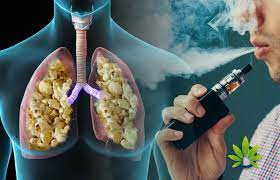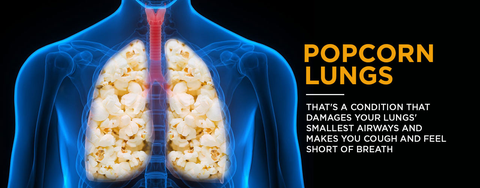
A lot of people are wondering if the popular smoking-cessation tools can cause popcorn lungs. Well, the reason is not far-fetched- since the rate of respiratory illnesses has been on the increase. But is it true that vaping can cause popcorn lung? Has there been any evidence to show that links vaping with popcorn lungs? That’s what you will learn in this article.
What is Popcorn lung?
Popcorn lung is a severe type of lung disease in which the tiny air sacs in the lungs become constricted and scarred. This results in no O2-CO2 exchange in the lungs, meaning no air movement.
This condition is serious and irreversible, and it is otherwise called bronchitis obliterans or obliterative bronchitis.
A link between the buttery-flavored chemical called diacetyl and popcorn lung was made over a decade ago when workers in a microwave popcorn factory were found to have this rare condition. Diacetyl has a tasty flavor - the reason why it is used in foods like popcorn, dairy products, and caramel.
Unfortunately, this flavored chemical has been linked to hundreds of cases of bronchiolitis obliterans and some deaths. When inhales, diacetyl can cause scarring of the tiny air sacs in the lungs, which causes the airways to thicken and become narrow.
This condition is dangerous, and it is often accompanied by symptoms like shortness of breath, coughing, and wheezing, which is similar to that of chronic obstructive pulmonary disease (COPD). All of these symptoms can occur two to eight weeks after exposure to the food flavoring fumes.
These symptoms caused by unsafe eliquids include
·prescription corticosteroids
·bronchodilators to open the airways
·cough suppressants
·immunosuppressant therapy to decrease your body’s immune response
·oxygen supplementation (in severe cases)

Popcorn lung can be fatal if left untreated, and the best way to prevent developing this condition is to avoid exposure to harmful flavored chemicals like diacetyl. Little wonder major popcorn manufacturers stopped adding diacetyl from their products
But some other products like e-cigarette still find this chemical use in a considerable amount as a flavoring agent. Many e-cigarette companies are now adding diacetyl to “e-juice” liquid to complement flavorings such as maple, vanilla, coconut, and more.
Is there any evidence about diacetyl and e-cigarettes?
A study was conducted in the U.S. in 2016 to know whether the e-cigarettes available at the time contained this flavored chemical. The result showed that 39 of the 51 e-liquid flavors sampled contained some amount of diacetyl.
These findings raised a lot of concerns that birthed the idea that e-cigarettes could cause popcorn lungs. But it didn’t show that there was an actual link between vaping and popcorn lungs in people.
Given the evidence from this study supporting the fact that diacetyl is dangerous and even fatal, it became worrisome to include it in many food products.
Besides, the report advises urgent action to further evaluate the widespread exposure to this chemical via flavored e-cigarettes.
Notably, in 2016, diacetyl was banned in e-cigarettes in the U.K. under the E.U. Tobacco Products Directive (TPD). So if you want to get e-liquids in the U.K., you can be sure none is containing diacetyl.
Can Vaping cause popcorn lung?
Since 2015, most of the e-cigarettes in the market contain flavored vape juice, and the diacetyl content makes the flavors richer. But the more the vapor is being breathed in, the high the risk of developing popcorn lung. That’s why you need to regulate the amount of e-liquid you take and the duration.
The diacetyl chemical is primarily found in flavored e-liquids, and they tend to be appealing to teenagers. So the more teenagers use these vape products, the more they get exposed to diacetyl and popcorn lungs.
So in essence, there is a chance, for sure, of getting popcorn lung from vaping, but there is no evidence to prove how common it can happen.
“It has been postulated that lung changes associated with vaping can be caused by vape flavorings, and the effect is not different from patients with the traditional popcorn lung disease,” says governor at the College of American Pathologists, Timothy C. Allen, M.D. However, this hypothesis hasn’t been proven by any biopsy studies on lung tissues of patients who use vaping products, he says.
Dr. Linda Barr, M.D. expert pulmonologist at St. Joseph Medical Center, University of Maryland said, “Most of the reported radiological patterns linked with vaping-related failures do not look like bronchiolitis obliterans (popcorn lung)”
“We have studied many vaping-related lung diseases, and popcorn lung doesn’t appear to be a type of lung injury related to vaping,” she added.
However, that doesn’t mean those who use flavored vape products are in the clear. “There is a significant concern that there will be reports of popcorn lungs in people who vape flavored solutions containing diacetyl,” says Dr. Barr.
More so, “It is still unclear, as of now, whether some vapes are safer than others since the main cause of the lung injury is not totally known,” said Dr. Robert Goldberg, M.D., a pulmonologist with Mission Hospital Orange County, California. “The majority of the devices that led to lung injury were black market devices, though some commercial devices have been seen to cause injury,” he added.
Safe and Unsafe Ingredients in a Vape
For a smooth flavor, E-juices basically contain Propylene Glycol (P.G.), Vegetable Glycerin (V.G.), or both. These ingredients are then combined with flavors (either natural or artificial) such as cherry, mint, grape, and many more. The blend of the base and flavorings create the unique experience that vapers get.
But if you want to vape safely, then you should consider the e-liquid ingredients.
The safe ingredients
Propylene glycol (P.G.): This ingredient is non-toxic, and it is mainly used to carry flavors in food products, as an additive in various medicines, and as an ingredient in food coloring. P.G. can be used alone in your vape, but for a smoother consistency, it is best to combine with V.G.
Vegetable Glycerin (V.G.): This liquid is also non-toxic, and it is known for being thick and very sweet. That’s why a base that is 100% V.G. is densely thick and challenging to vape. Hence, it is recommended to blend with P.G.
Unsafe ingredients
The safety of your e-juice lies in certain chemicals that can be found in the flavor. Some ingredients are safe, but there are some ingredients that are unsafe. That’s why you need to know how to read labels to know the ingredients to avoid.
Below are some unsafe ingredients to avoid in your e-liquid:
·Diacetyl
·Diketones
In conclusion, many vape products/e-cigarettes sold on a full-scale today contain some amount of diacetyl, which triggers popcorn lung, but they are less harmful than smoking tobacco. However, the association between vaping and popcorn has not been proven by any studies.
